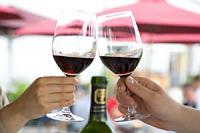 Happy 4th of July! Those of us in the United States celebrate the anniversary of the adoption of the Declaration of Independence on July 4th 1776. Immediately after declaring independence from Great Britain, the representatives in the Continental Congress drank a toast with glasses of Madeira wine.
Happy 4th of July! Those of us in the United States celebrate the anniversary of the adoption of the Declaration of Independence on July 4th 1776. Immediately after declaring independence from Great Britain, the representatives in the Continental Congress drank a toast with glasses of Madeira wine.
Why Madiera? It was virtually the only wine available in the American colonies at the time. Wine carried by sailing ship was often spoiled in transit by the constant jostling of the ship and the wide variations of heat and cold. Wine from the island of Madeira, however, was fortified with a small amount of sugar cane brandy to help it survive the ocean voyage. Not only did the fortified wine survive the voyage but it was found that the heat and motion of the ship actually improved the quality of the wine.
During the 17th and 18th centuries, the Portuguese island of Madeira, in the Atlantic directly west of Morocco, was a popular port of call for ships trading in Europe, the Mediterranean and Africa. Ships would often stop for provision either before or after the long trip across the Atlantic. In addition to stocking up on the local wine for shipboard consumption, the wine became popular as a durable export commodity. By the end of the 18th century, the United States was importing roughly a quarter of all the Madeira on the market.
In addition to providing the toast in honor of the signing of the Declaration of Independence, Madeira also played a key role in the American revolution itself. In June of 1768, the British Commissioners of Customs seized the sloop Liberty, owned by John Hancock. Hancock was the richest man in the colonies and some claim was also a notorious smuggler. (Historians still debate the point.) Hancock’s sloop Liberty was carrying a cargo of, you guessed it, Madeira wine.
Hancock’s sloop was seized by Customs because it was loaded with significantly more pipes of Madeira than were claimed in the Customs declaration and for which duties were paid. For decades this sort of blatant evasion of customs duties would have been greeted with a wink, a nod and perhaps a small payoff. The problem was, the British had grown tired of the Americans not paying their fair share, so the Crown had sent a new batch of Customs Commissioners to crack down on smuggling. And how better to demonstrate their earnestness than to arrest one of Hancock’s ship?
If their action was intended to intimidate the Americans, the Commissions seriously miscalculated. The mood in the port of Boston was ugly to begin with. The British ship, HMS Romney had pressed several sailors the day before the seizure and the Boston mob; a mix of sailors, longshoremen, craftsmen and just about anyone hanging garound the docks; was on the streets trying, without success, to save the pressed sailors from their Royal Navy captors.
When the Liberty was seized, the mob was already assembled. The sloop was taken over by British marines and towed into the harbor. The Commissions of Customs, unfortunately, had not planned for their own escape. They found themselves standing on the docks facing the Boston mob. No one was reported to be killed but the commissioners were much worse for the wear by day’s end.
And what of Hancock’s cargo of Madeira, which was stacked up on the dock? One writer has referred to the day as the “Boston Madeira Party.” Unlike the better known “Boston Tea Party” of 1773, where tea was thrown in the harbor, the mob in the “Boston Madeira Party” chose to drink the wine rather than dump it. A yacht owned by the chief customs collector was dragged out of the water and carried on the shoulders of the mob from the dock to Boston Commons, where it was burned. More pipes of wine were also carried to the Commons and the festivities grew until, according to some accounts, Sam Adams bade the revelers go home.
In direct response to the Liberty Riots, as they became known, the British Army occupied Boston in October of 1778. Hancock’s sloop Liberty was taken into the Customs’ service and was burned by a mob in Newport, Rhode Island in 1769. Following the seizure of the Liberty, John Hancock became increasingly active in the revolutionary movement. As President of the Second Continental Congress in 1776, his signature on the Declaration of Independence is the largest on the document. Indeed, “John Hancock” has become slang for “signature.”
So on this Independence Day, suggest we all shall raise a glass of whatever we may be drinking, and offer a toast to Independence and to Madeira wine.

Great article. But I’m surprised to read that any historian doubts that Hancock was not paying all of his duties (smuggling.) Any sources on that, off-hand?
I missed the whole thing, slept right through it.
Blame the vodka, or was it the beer?
Pingback: Portugal’s Other Fortified Gem: Madeira | The Society of Wine and Jurisprudence